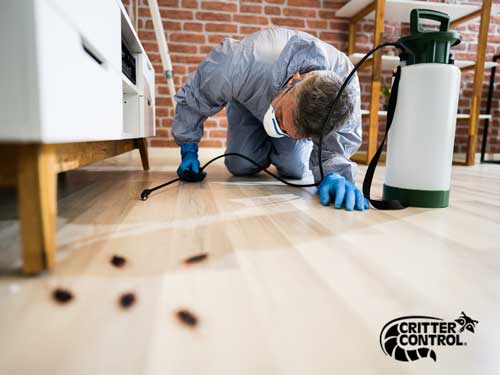A1 Pest Control Charlotte NC Bed Bugs - Specialist Extermination Services
Wiki Article
Bed Insect Therapy Breakdown: Contrasting Chemical Vs. Non-Chemical Solutions
In the realm of insect control, particularly when handling the relentless concern of bed bugs, the choice between chemical and non-chemical therapy solutions can be a critical one. Both approaches use distinct advantages and downsides, affecting factors such as efficiency, security considerations, and total cost. By analyzing the nuanced details of each technique, a more clear understanding of which course to go after in attending to a bed bug invasion can be obtained.Performance of Chemical Treatments
Chemical therapies for bed bug invasions have actually been commonly acknowledged for their fast and potent efficiency in removing these insects. When taking into consideration the efficiency of chemical therapies, it is crucial to comprehend that they can provide a thorough and fast remedy to a bed pest issue. Professional exterminators usually count on insecticides to target bed pests at numerous stages of their life cycle, consisting of eggs, nymphs, and adults. These chemicals commonly work by interrupting the bed pests' nerves, resulting in paralysis and ultimate death.In addition, chemical treatments have the benefit of providing recurring impacts, implying that they can continue to eliminate bed pests also after the initial application. This recurring action is especially helpful in combating any type of prospective re-infestations. In addition, the quick activity of chemical therapies can bring alleviation to individuals encountering severe bed bug infestations, enabling them to restore control of their space swiftly.
Safety And Security Worries With Chemical Solutions
When using chemical services for bed bug therapy is guaranteeing the safety and security of passengers and the atmosphere,One important aspect that needs cautious consideration. While chemical therapies can be effective in eliminating bed pests, they might posture dangers otherwise dealt with correctly. Among the main safety concerns with chemical options is the potential damage they can create to human health and wellness. Direct exposure to particular chemicals made use of in bed pest treatments can bring about breathing concerns, skin inflammation, or other adverse responses, specifically in people with pre-existing problems or level of sensitivities. Furthermore, incorrect application or dosage of chemical pesticides can cause harmful deposits lingering in the treated location, presenting long-term health dangers to residents.Additionally, the ecological impact of chemical solutions is another substantial consideration. Some pesticides utilized in bed insect treatments may be hazardous to helpful bugs, wildlife, and ecological communities if they leach into the soil or water systems. It is vital to use chemical therapies carefully, complying with safety and security guidelines, and taking into consideration much less poisonous choices to reduce these threats and make certain the secure and efficient management of bed pest infestations.
Advantages of Non-Chemical Methods
Taking into consideration the prospective safety problems and environmental effect related to chemical remedies for bed insect treatment, checking out non-chemical techniques presents an appealing option with several unique benefits. Non-chemical techniques supply a much safer alternative for families, particularly those with youngsters, individuals, or animals conscious harsh chemicals. These techniques get rid of the threats of exposure to poisonous materials, decreasing the possibility for damaging wellness effects. Moreover, non-chemical treatments are eco-friendly, as they do not add to air or water air pollution, making them a lasting choice for parasite control.In addition, non-chemical solutions can be efficient in targeting bed insects, including hard-to-reach areas where chemical treatments may not pass through - A1 exterminator charlotte nc. Methods such as warm treatment, vacuuming, vapor cleansing, and cushion encasements give detailed eradication without the use of damaging chemicals.
Limitations of Non-Chemical Treatments

Additionally, non-chemical therapies typically call for multiple applications to attain effective elimination. This can be taxing and may not always guarantee complete removal of all bed pests and their eggs, especially in hard-to-reach or covert areas.
Additionally, the success of non-chemical therapies greatly counts on appropriate execution and thoroughness, which can be testing for individuals without expert proficiency. Inadequate application of non-chemical methods might cause incomplete elimination, bring about consistent invasions and the need for extra therapies.
For that reason, while non-chemical treatments have their advantages, it is vital to acknowledge these restrictions and consider them when determining the most reliable technique for handling bed insect invasions.
Expense Contrast: Chemical Vs. Non-Chemical Options
Offered the restrictions linked with non-chemical treatments, an essential element to examine in the context of bed insect monitoring is the cost comparison in between chemical and non-chemical options. In comparison, non-chemical treatments like heat therapy or heavy steam can be more pricey, with costs ranging from $1,000 to $6,000 for a whole home. While the preliminary price of chemical treatments may seem reduced, multiple therapies might be required to completely get rid of the problem, possibly increasing the general cost.Verdict

Considering the possible safety and security problems and A1 pest control services charlotte ecological influence linked with chemical solutions for bed pest therapy, discovering non-chemical techniques provides an encouraging option with a number of unique benefits.Provided the limitations linked with non-chemical therapies, a necessary aspect to assess in the context of bed bug monitoring is the expense comparison between chemical and non-chemical options. In comparison, non-chemical treatments like heat therapy or heavy steam can be much more pricey, with prices ranging from $1,000 to $6,000 for an entire home. While the preliminary cost of chemical therapies may seem lower, multiple treatments might be required to completely remove the problem, possibly enhancing the overall cost.In final thought, when comparing chemical and non-chemical bed pest therapy choices, it is important to consider effectiveness, safety and security, benefits, limitations, and price.
Report this wiki page